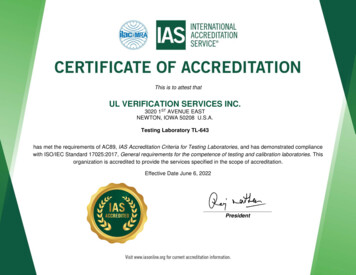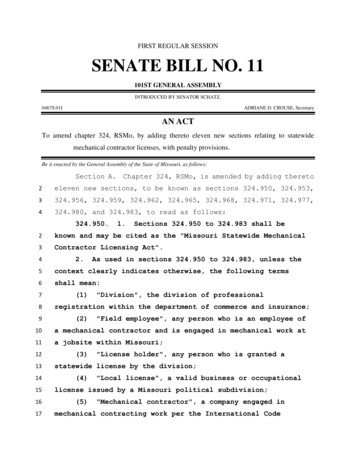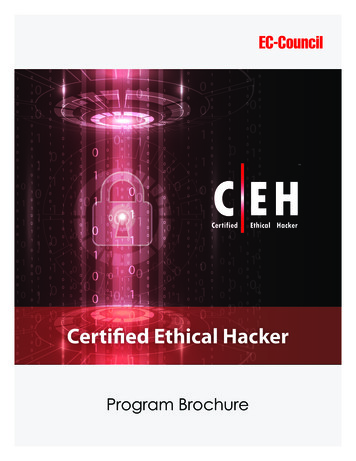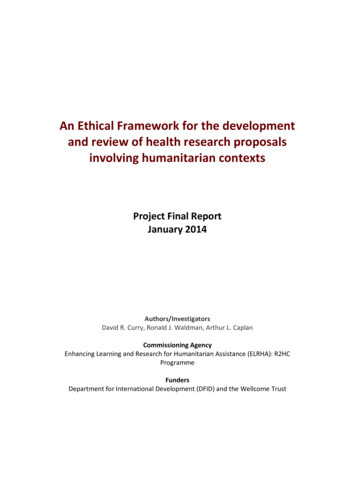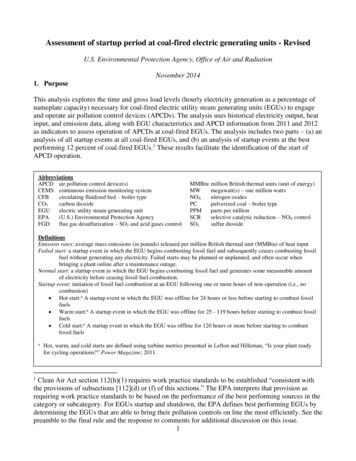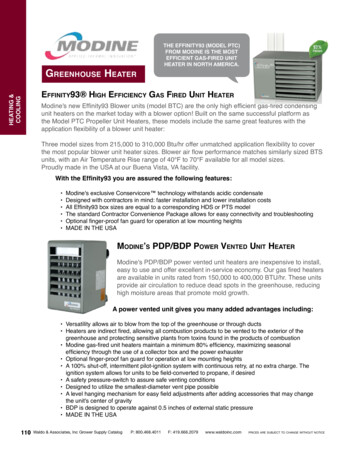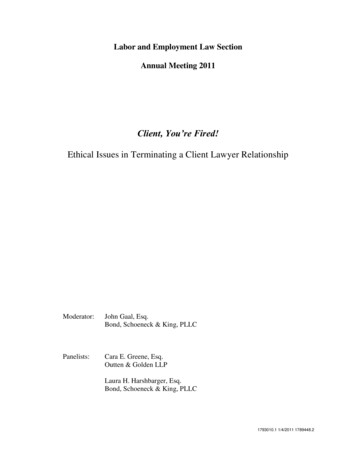
Transcription
Labor and Employment Law SectionAnnual Meeting 2011Client, You’re Fired!Ethical Issues in Terminating a Client Lawyer RelationshipModerator:John Gaal, Esq.Bond, Schoeneck & King, PLLCPanelists:Cara E. Greene, Esq.Outten & Golden LLPLaura H. Harshbarger, Esq.Bond, Schoeneck & King, PLLC1793010.1 1/4/2011 1789448.2
I.Terminating the Client-Attorney RelationshipA.Mandatory Withdrawal(1)The General Rule. An attorney is required to withdraw fromrepresentation in four situations: if continuing the representation will result in a violationof the law or rules, if the attorney is unable to represent the client due to a physical ormental if impairment, the client fires the attorney, or if the client is bringing the lawsuitmerely to harass or injure another person.(a)New York Rules of Professional Conduct (“Rule(s)”)Rule 1.16(b)1: a lawyer shall withdraw from the representation ofclient when:(1) the lawyer knows or should know that therepresentation will result in a violation of theseRules or of law;(2) the lawyer's physical or mental conditionmaterially impairs the lawyer's ability to representthe client;(3) the lawyer is discharged; or(4) the lawyer knows or reasonably should knowthat the client is bringing the legal action,conducting the defense, or asserting a position inthe matter, or is otherwise having steps taken,merely for the purpose of harassing or maliciouslyinjuring any person.(b)Mandatory withdrawal is required under Rule 1.16(b)(1) whenconflicts arise during the course of concurrent representation and the conflicteither cannot be waived or one party will not agree to waive the conflict.In Formal Opinion 2005-05, 2005 WL 6631005 (“NYCBAOpinion 2005-05”), the New York City Bar Association’s Committee on1Rule 1.16 was formerly Code of Professional Responsibility Disciplinary Rule 2-110.21793010.1 1/4/2011 1789448.2
Professional and Judicial Ethics (the “NYCBA Ethics Committee”) discussed thelatter situation: when unforeseeable, waivable conflicts arise between concurrentclients and one client is unwilling to waive the conflict.2 As explained in Opinion2005-05, “when two clients will not consent to a conflict of interest, and theconflict requires consent, the law firm must withdraw from representation of atleast one of the clients.” 2005 WL 6631005 at *4.As an initial matter, the NYCBA Ethics Committee determinedthat if continued representation of one client would require the use of materialconfidential information of the other client, then the attorney must withdraw fromrepresenting both clients, since the duty of confidentiality extends to formerclients. See Rule 1.9. As the NYCBA Ethics Committee explained, “Inparticular, the confidences and secrets of the former client must be protected, andno attorney may continue an adverse representation . . . in which materialconfidences or secrets of either client (or former client) will be placed at risk.”2005 WL 6631005 at *12.Assuming material confidential information will not be placed atrisk, the question then is how should the attorney decide which client to representgoing forward? The NYCBA Ethics Committee identified several factors thatshould guide the decision. The most important factor is the prejudice thewithdrawal or continued representation will cause the respective parties and2All of these Opinions were issued under the prior Code of Professional Responsibility, not the current Rules ofProfessional Conduct. However, there is little substantive difference between the Code and the Rules as concernsthese issues, unless specifically noted.31793010.1 1/4/2011 1789448.2
whether representing one client will give an unfair advantage to that client. Otherfactors to consider are:the origin of the conflict (which client’s actionscaused the conflict to arise);whether one client has manipulated the conflict totry to force a lawyer off the matter and is using theconflict as leverage;the costs and inconvenience to the party beingrequired to obtain new counsel, including thecomplexity of the representation;whether the choice would diminish the lawyer’svigor of representation towards the remainingclient;and, the lawyer’s overall relationship to each client.2005 WL 6631005 at *8.(2)Securing the Tribunal’s Permission(a)Rules of Professional Conduct:Rule 1.16(d): If permission for withdrawal from employment isrequired by rules of a tribunal, a layer shall not withdraw fromemployment in a matter before that tribunal without its permission.When ordered to do so by a tribunal, a lawyer shall continuerepresentation notwithstanding good cause for terminating therelationship.(b)Compilation of Codes, Rules and Regulations of the State of NewYork:22 NYCRR 604.1(6): Once a client has employed an attorney whohas entered an appearance, the attorney shall not withdraw orabandon the case without (i) justifiable cause, (ii) reasonable noticeto the client, and (iii) permission of the court.(c)An attorney may not withdraw from representing a client, even ifwithdrawal is mandatory under Rule 1.16(b), unless the attorney has secured the41793010.1 1/4/2011 1789448.2
necessary permission of the respective tribunal. Under 22 NYCRR 604.1(6), inorder to withdraw from a case where an attorney has entered an appearance inNew York state court, the attorney must show that the withdrawal is justified,must give reasonable notice to the client, and must receive the court’s permission.Courts considering whether to permit withdrawal look to theprejudicial effect the withdrawal would have on the client. See, e.g., Alter v.Oppenheimer & Co., Inc., 2008 WL 5050071 (N.Y. Sup. Ct. Nov. 20, 2008). InAlter, two law firms sought to withdraw from representing an individualdefendant in a sexual harassment lawsuit after Oppenheimer (the corporatedefendant who also was represented by the two law firms) reached a settlementwith the plaintiff on the eve of trial. The law firms claimed that the settlementcreated a conflict between Oppenheimer and the individual defendant,necessitating withdrawal. Alternatively, the law firms claimed that the individualdefendant had lost confidence in their ability, making it unreasonably difficult forthem to carry out their employment effectively.Ultimately, the court denied the request to withdraw therepresentation. The court first concluded that there was no conflict between theparties because Oppenheimer was no longer a defendant in the matter. Id. at *5.Next, the court found that neither law firm had demonstrated that the attorneyclient relationship was “irrevocably broken.” Id. at *6. Finally, the courtconcluded that permitting withdrawal would have a materially adverse effect onthe defendant’s ability to vigorously defend himself at trial, given that the motion51793010.1 1/4/2011 1789448.2
for withdrawal was made only four days before the trial was scheduled tocommence. Id.In Riley v. Segan, Nemerov & Singer, P.C., 2009 WL 5299224(Bronx Sup. Ct. Dec. 14, 2009), a malpractice case, the court considered whatconstitutes reasonable notice under 22 NYCRR 604.1(6).An attorney is required to provide reasonable notice to the clientwhen withdrawing from representation, and no definition ofreasonable notice would require a client to infer, from ambiguousaction or inaction on the part of the attorneys, . . . that she is nolonger represented. . . . [M]ore than equivocal behavior [is]required to sever the relationship.Id. at *4 (quoting Gotay v. Breitbart, 58 AD3d 25 (1st Dept. 2008)). TheRiley court concluded that notice of withdrawal must be communicatedunambiguously; in that case, through an in-person oral communication, asopposed to a crafted letter. 2009 WL 5299224 at *5.B.Permissive Withdrawal(1)The General Rule. Unlike the Code of Professional Conduct, whichcontained only eight circumstances in which withdrawal was permitted, the Rules ofProfessional Responsibility include 13 different circumstances in which an attorney maywithdraw from representing a client. Importantly, under the Rules, withdrawal ispermitted for any reason if it can be accomplished without materially harming theinterests of the client.(a)Rules of Professional ConductRule 1.16(c): a lawyer may withdraw from the representation ofclient when:(1) withdrawal can be accomplished without materialadverse effect on the interests of the client;61793010.1 1/4/2011 1789448.2
(2) the client persists in a course of action involving thelawyer's services that the lawyer reasonably believes iscriminal or fraudulent;(3) the client has used the lawyer's services to perpetrate acrime or fraud;(4) the client insists upon taking a course of action withwhich the lawyer has a fundamental disagreement;(5) the client deliberately disregards an agreement orobligation to the lawyer as to expenses or fees;(6) the client insists upon presenting a claim or defense thatis not warranted under existing law and cannot besupported by go faith argument for an extension,modification, or reversal of existing law;(7) the client fails to cooperate in the representation orotherwise renders the representation unreasonably difficultfor the lawyer to carry out employment effectively;(8) the lawyer's inability to work with co-counsel indicatesthat the best interest of the client likely will be served bywithdrawal;(9) the lawyer's mental or physical condition renders itdifficult for the lawyer to carry out the representationeffectively;(10) the client knowingly and freely assents to terminationof the employment;(11) withdrawal is permitted under Rule 1.13(c) or otherlaw;(12) the lawyer believes in good faith, in a matter pendingbefore a tribunal, that the tribunal will find the existenceof other good cause for withdrawal; or(13) the client insists that the lawyer pursue a course ofconduct which is illegal or prohibited under these Rules.71793010.1 1/4/2011 1789448.2
(b)If the tribunal requires permission to withdraw, the attorney mustsecure the tribunal’s permission, even if withdrawal is otherwise permitted underthe Rules. See Rule 1.16(d); Section I(A)(2), supra.(2)Using Retainer Agreements to Facilitate Permissive Withdrawal.Retainer agreements are a regularly-used vehicle for outlining thecircumstances in which an attorney may withdraw as counsel. For instance, a retaineragreement may specify that an attorney may withdraw from representation if, afterinvestigation or consultation with experts, the attorney is convinced that the defendant isnot liable. See NYSBA Committee on Professional Ethics Formal Opinion (“NYSBAFormal Opinion”) 440 (1976). A retainer agreement may also set forth other grounds forterminating the client-attorney relationship, as long as they are consistent with thegrounds set forth in Rule 1.16(c). See NYSBA Formal Opinion 719.The existence of a retainer agreement specifying certain grounds forterminating the client-attorney relationship does not relieve an attorney of his obligationto seek the court’s permission, if necessary. See NYSBA Formal Opinion 440. Nor maya retainer agreement “mislead the client with regard to the attorney’s obligations,including the obligation to continue as counsel in the absence of a permissible ground forwithdrawing from the representation.” NYSBA Formal Opinion 719.II.Protecting the Former ClientA.Avoiding Prejudice.A withdrawing attorney has an obligation to protect the former client’s interest byavoiding foreseeable prejudice to the rights of the client.(1)Rules of Professional Conduct81793010.1 1/4/2011 1789448.2
Rule 1.16(e): Even when withdrawal is otherwise permitted or required,upon termination of representation, a lawyer shall take steps, to the extentreasonably practicable, to avoid foreseeable prejudice to the rights of theclient, including giving reasonable notice to the client, allowing time foremployment of other counsel, delivering to the client all papers andproperty to which the client is entitled, promptly refunding any part of afee paid in advance that has not been earned and complying withapplicable laws and rules.(2)What constitutes reasonable notice is discussed in Section I(A)(2)(c),supra. An attorney’s obligations related to producing the client’s file are discussed inSection III, infra, and obligations where an attorney’s fee is disputed are discussed inSection V, infra.B.Post-Withdrawal Obligations.Even after an attorney has withdrawn from representing a client, the attorneycontinues to have certain obligations to the now-former client, including an obligation to avoidconflicts of interest and a duty of confidentiality.(1)Conflicts of Interest(a)General Rule: Absent the former client’s written informedconsent, an attorney may not represent another in the same or a substantiallyrelated matter in which the new client and former client’s are materially adverse.(b)Rules of Professional ConductRule 1.9:(a) A lawyer who has formerly represented a client in a mattershall not thereafter represent another person in the same or asubstantially related matter in which that person’s interests arematerially adverse to the interests of the former client unless theformer client gives informed consent, confirmed in writing.(b) Unless the former client gives informed consent, confirmed inwriting, a lawyer shall not knowingly represent a person in thesame or a substantially related matter in which a firm with which91793010.1 1/4/2011 1789448.2
the lawyer formerly was associated had previously represented aclient: (1) whose interests are materially adverse to that person;and (2) about whom the lawyer had acquired information protectedby Rules 1.6 or paragraph (c) of this Rule that is material to thematter.(c)Substantial Relationship TestIn the Second Circuit, matters are substantially related if therelationship between the issues in the present and former representations is“patently clear” or those issues are “identical” or “essentially the same.”Government of India v. Cook Indus., Inc., 569 F.2d 737 (2d Cir. 1978); Loomis v.Consolidated Stores Corporation, 2000 U.S. Dist. LEXIS 12391 (S.D.N.Y. 2000);Rosewood Apartments Corp. v. Perpignano, 2000 U.S. Dist. LEXIS 1255(S.D.N.Y. 2000); Witorsch v. Notaris, 1997 U.S. Dist. LEXIS 12805 (S.D.N.Y.1997). Neither the fact that the two representations share a common area of thelaw nor just any factual connection will suffice; the matters must be sufficientlyrelated that information disclosed in the earlier representation will be useful in thelatter case. Silva Run Worldwide Limited v. Gaming Lottery Corp., 1999 U.S.Dist. LEXIS 9150 (S.D.N.Y. 1999); see also Cleverly Minded Limited v.Anthony Sicari Apparel Group Industries, Inc., 2003 U.S. Dist. LEXIS 855(S.D.N.Y. 2003) (general knowledge about former client, his business practicesand his assets not sufficient to disqualify attorney unless those matters are in issuein later case); Regal Marketing Inc. v. Sonny & Son Produce Corp., 2002 U.S.Dist. LEXIS 14069 (S.D.N.Y. 2002) (“A substantial relationship will beestablished between the two representations if facts pertinent to the problems forwhich the original legal services were sought are relevant to the subsequent101793010.1 1/4/2011 1789448.2
litigation.”); Rosewood Apartments v. Perpignano, 2000 U.S. Dist. LEXIS 1255(principal focus must be on degree of overlap between factual and legal issues, toshed light on likelihood that former client disclosed confidential information toattorney that may be useful in representing new client); NYSBA Formal Opinion723 (1999) (factors tending to show a substantial relationship include an identityof issues between the two matters, a significant overlap in contested facts betweenthe two matters, or where the issue in controversy in the second matter arose outof a transaction in which the lawyer represented the former client); see alsoSanders v. Woods, 2004 Wash. App. LEXIS 939 (Wash. App. 2004) (lawyerwhose partner had previously advised an employer with respect to its noncompete clause precluded from representing former employee in action broughtby that employer to enforce the non-compete clause; prior representation ofemployer substantially related to current adverse representation of formeremployee).In New York State courts, prior to the adoption of the Rules, theemphasis was more on access to confidential information than on the existence ofcommon issues. See Claramont v. Kessler, 2000 N.Y. App. Div. LEXIS 1058 (1stDep’t 2000) (acquisition of confidential information in prior representation ofadverse party which is likely to be an issue in subsequent case provides basis fordisqualification). Comment 3 to Rule 1.9 now provides that “[m]atters are‘substantially related’ . . . if they involve the same transaction or legal dispute orif, under the circumstances, a reasonable lawyer would conclude that there is asubstantial risk that confidential factual information that would normally have111793010.1 1/4/2011 1789448.2
been obtained in the prior representation would materially advance the client’sposition in the subsequent matter.”In the Second Circuit, the fact that matters are substantially relatedcreates a presumption of shared confidences which supports the disqualificationof the attorney in the latter, adverse case. This presumption is rebuttable. See,Silver Chrysler Plymouth v. Chrysler Motors Corp., 518 F.2d 751 (2d Cir. 1975);Rocchigian v. World Boxing Council, 2000 U.S. Dist. LEXIS 755 (S.D.N.Y.2000); Schwed v. Gen. Elec. Co., 990 F. Supp. 113 (N.D.N.Y. 1998). In verylimited circumstances, state courts in New York have also indicated thepresumption may be rebutted. See Solow v. W.R. Grace & Co., 83 N.Y. 2d 303(1994); but see Trustco Bank N.Y. v. Melino, 164 Misc.2d 999 (Sup. Ct. 1995)(indicating an irrebutable presumption).(d)Defining “Former” Client(i)Representation For a Distinct Matter. Because of thesignificant difference in the standard applicable to representation ofconcurrent and former clients with adverse interests, establishing that anattorney-client relationship has previously terminated can be critical.Where employment of a lawyer is for a specific matter, and substantiveservices related to the matter have come to an end, the client may becharacterized as a former client. See G.D. Searle & Co. v. Nutrapharm,Inc., 1999 U.S. Dist. LEXIS 5963 (S.D.N.Y. 1999).(ii)Continuous Relationships. However, where the attorneyand the client’s relationship is continuous and longstanding, the fact that121793010.1 1/4/2011 1789448.2
there is no particular matter currently being handled by the lawyer is notenough to make the client a “former” client. See Credit Index, LLC v.RiskWise, LLC, 192 Misc.2d 755, 746 N.Y.S.2d 885 (New York Co.,2002)(finding that client was a current client where firm represented clienton various matters over the course of four years, including a month beforeundertaking a case adverse to the client, and the firm never sent a letterterminating its relationship with the client); Credit Index L.L.C. v. RiskWise Intl. L.L.C., 192 Misc. 2d 755 (N.Y. Cty.) aff’d in part, 296 A.D. 2d318 (1st Dep’t 2002) (fact that firm had no open matters on date inquestion does not make client who has used firm’s services on anintermittent, as needed basis, a former client).(e)Creating a Former Client: The Hot Potato RuleA lawyer generally may not drop an existing client in the midst ofan active representation, like a “hot potato,” when a conflict arises and therebyavoid the “current client” standard and rely on the less rigorous “substantialrelationship” test applicable to former clients. See MERCK EPROVA AG v.Prothera, Inc., 08 CW 0035 (S.D.N.Y. 2009) reported in NYLJ (October 19,2009). Anderson v. Nassau County Department of Corrections, 376 F. Supp. 2d294 (E.D.N.Y. 2005); Ehrich v. Binghamton City School Dist., 210 F.R.D. 17(N.D.N.Y. 2002); Strategem Dev. Corp. v. Herons Int’l, N.V., 756 F. Supp. 789.(S.D.N.Y. 1991). See also discussion in New York City Opinion 2005-02.However, even when the “hot potato” rule is applicable, disqualification is notautomatic. E.g. Universal City Studios, Inc. v. Reimerdes, 98 F. Supp.2d 449131793010.1 1/4/2011 1789448.2
(S.D.N.Y. 2000) (no disqualification without significant risk of trial taint); seealso University of Rochester v. G. D. Searle & Co., Inc., 2000 U.S. Dist. LEXIS19030 (W.D.N.Y. 2000) (generally under per se rule of disqualification involvingcurrent clients, disqualification still requires showing of trial taint).(f)Conflicts Created by the Lateral Movement of Lawyers: ScreeningDevices and Disclosure ObligationsThe lateral movement of lawyers between firms can frequentlygive rise to conflict issues and the possibility of lawyer and firm widedisqualification. The appropriate outcome is very fact specific and can depend onmany variables, including whether the disqualification is directed at the firm fromwhich the tainted lawyer has departed or the firm to which the tainted lawyer hasmoved.(i)New York: Departing LawyersGenerally there is a presumption that client confidentialinformation learned by one firm attorney is shared with all other firmattorneys. Historically in New York, because of this presumption, thedeparture of the particular lawyer who had received a client confidencedid not remove the conflict possibility for the remainder of the firm whenit sought to undertake representation adverse to a former client of thedeparting lawyer. In Solow v. W.R. Grace, 83 N.Y.2d 303 (1994), theCourt recognized that in limited circumstances the presumption of sharedconfidences is subject to rebuttal. There the presumption was rebuttedbecause the attorney who actually possessed any former client confidenceshad left the firm, there was no evidence that she in fact shared any of those141793010.1 1/4/2011 1789448.2
confidences with any lawyer still at the firm, and the firm was a large,departmentalized firm which, in itself, lessened the basis for simply“presuming” confidences were shared. Consequently, the firm in Solowwas not disqualified from representing a new client in a matter adverse tothe former client who had been previously represented by the departedattorney.Modification in 1999 to New York’s DR 5-108, subpart (C)(now reflected in New York Rule 1.10(b)), codifies much of the Solowholding. This provision now prohibits a firm from undertakingrepresentation of a client adverse to the interests of a former client whowas represented by a departed attorney only if the firm (includingaccessible files of the firm), or any remaining lawyer in the firm, actuallypossesses confidential information which is material to the newrepresentation. See New York Rule 1.10, cmt 5[A]. Model Rule 1.10(b)is similar. Even if such confidences do still reside in the firm,representation of the new client is permissible with the consent, after fulldisclosure, of the former client.(ii)New York: Incoming LawyersUnder New York’s Rules (and prior DR 5-108), a lawyerentering a firm is generally considered to bring her conflicts with her,thereby giving rise to at least the potential for the disqualification of boththat lawyer and her new firm in pending matters. There has beenconflicting authority as to whether this rule applies where the client151793010.1 1/4/2011 1789448.2
confidences the new lawyer brings with her are not actually known to her,but were only those imputed to her through her prior association with thelawyers in her former firm. Compare Young v. Central Square CentralSchool Dist., 2002 U.S. Dist. LEXIS 13480 (N.D.N.Y. 2002) (small firm);Cardinale v. Golinello, 43 N.Y.2d 288 (1977) (small firm marked byinformality supports presumption of shared confidences resulting indisqualification of lawyer and new firm); Schwed v. General Electric Co.,990 F. Supp. 113 (N.D.N.Y. 1998); Hernandez v. Paoli, 255 A.D.2d 130(1st Dep’t 1998), with NYSBA Formal Opinion 638 (1992) (DR 5-108 (A)only applicable where new lawyer brings actual knowledge, not imputedknowledge, to new firm); Nassau County Opinion 96-16 (1996) (same).New York Rule 1.10(c), in language similar to its predecessor DR 5-108,seemingly incorporates the actual knowledge standard with respect to theincoming lawyer herself, by providing that that lawyer is prohibited fromrepresenting a client with interests adverse to a client of her former firm ina matter substantially related to that prior representation unless the lawyer“did not acquire” any confidential information.NYSBA Formal Opinion 723 (1999), issued after DR 5108 was first amended to reflect this rule (and before adoption of NewYork’s Rules), adopts this knowledge standard, although it recognizes thatthere is a presumption of shared confidences among lawyers in a firmwhich follows the lawyer to her new firm. Nonetheless, the presumptioncan be rebutted by showing inter alia that the attorney’s prior firm was a161793010.1 1/4/2011 1789448.2
large, departmentalized firm in which client confidences were notroutinely shared across the firm. This “confidential information” standardis now codified in the Rules at Rule 1.9(b).If a lawyer personally represented a client at her formerfirm, she may not represent a client at her new firm in the same or asubstantially related matter, if the interests of the new and former clientsare materially adverse. The following principles are noteworthy:It is possible to do work for a client without representingthat client (e.g., research on a discrete legal issue whichinvolved no access to client confidences or secrets).If a lawyer obtained or had access to confidentialinformation, however, she may be deemed to haverepresented that client.If a lawyer is precluded from representing her new clientunder this rule, generally so is her new firm.If the moving lawyer did not personally represent the firstclient (only her former firm did so), she will be prohibited fromrepresenting the client of her new firm only if (1) the interests of the twoclients are materially adverse and (2) she actually acquired confidentialinformation of the first client which are material to the representation.If the lawyer moved from a small firm “whose activitieswere characterized by an understandable formality” she171793010.1 1/4/2011 1789448.2
will be irrebutably presumed to have received confidentialinformation.If, on the other hand, she came from a large,departmentalized firm, she may be able to demonstrate thatshe did not in fact gain much information.If the lawyer is disqualified from representing the secondclient, generally so is her new firm.(3)Duty of Confidentiality(a)General Rule: An attorney may not use a former client’sconfidential information to the detriment of the client or reveal a former client’sconfidential information, unless otherwise permitted by the Rules.(b)Rules of Professional ResponsibilityRule 1.9(c): A lawyer who has formerly represented a client in amatter or whose present or former firm has formerly represented aclient in a matter shall not thereafter: (1) use confidentialinformation of the former client protected by Rule 1.6 to thedisadvantage of the former client, except as these Rules wouldpermit or require with respect to a current client or when theinformation has become generally known; or (2) revealconfidential information of the former client protected by Rule 1.6except as these Rules would permit or require with respect to acurrent client.Rule 1.6(a): . . . “Confidential information” consists ofinformation gained during or relating to the representation of aclient, whatever its source, that is (a) protected by the attorneyclient privilege, (b) likely to be embarrassing or detrimental to theclient if disclosed, or (c) information that the client has requestedbe kept confidential.(c)It is important to note that there is a distinction between “using”information and “revealing” confidential information. Under the Rules, there are181793010.1 1/4/2011 1789448.2
circumstances in which a lawyer may be entitled to use information gained from aprior representation but not entitled disclose or reveal the information, either to asubsequent client or in the course of that client’s representation. By way ofillustration, a lawyer who represents a client against Company X uncovers a seriesof incriminating emails from the CEO to upper management. In a subsequentrepresentation against Company X, the lawyer may be allowed to use thedocuments to formulate questions at a deposition and to frame document requests,but not be allowed to show the documents to the second client. Of course, thelawyer may both use and reveal the documents if the former client gives herinformed consent.A lawyer is only restricted from using information related to therepresentation of a client where using the information would “disadvantage” theclient.3 A broader set of information – all information “relating to therepresentation of a client,” is protected by Rule 1.6. This Rule does not prohibit alawyer from using the information – only from revealing the information, withoutinformed consent. See ABA Comm. on Ethics and Prof’l Responsibility, FormalOp. 00-417 (April 7, 2000) (“[F]rom a policy point of view, the subsequent use ofinformation relating to the representation of a former client is treated quiteliberally as compared to restrictions regarding disclosure of client information.”).Before using information gained in the course of representing oneclient in a subsequent representation, a lawyer should carefully consider whetherthe use of the information will disadvantage the prior client. If the information is3This prohibition protects both current clients and former clients. Rule 1.8(b) (current client); Rule1.9(c)(1) (formerclient).191793010.1 1/4/2011 1789448.2
general information about the employer’s policies and practices, like payroll data,human resources policies, or internal company memoranda, its use is not likely toaffect the prior client’s interests. If however, use of the information could lead toliability for the prior client, or damage the prior client’s reputation, the lawyershould not use the in
(2) the client persists in a course of action involving the lawyer's services that the lawyer reasonably believes is criminal or fraudulent; (3) the client has used the lawyer's services to perpetrate a crime or fraud; (4) the client insists upon taking a course of action with which the lawyer has a fundamental disagreement;
